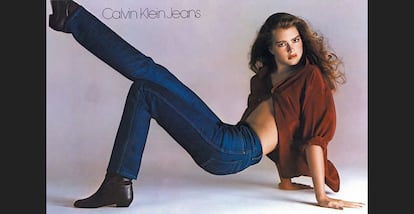From Kate Moss to Jeremy Allen White: The secret formula of the most famous white underwear in history
The combination of eroticism, a star photographer and a godlike model has been a hit since Calvin Klein first captured New York’s attention in the 1980s

In the early 1980s, Calvin Klein was already a big name in New York. The creator of “designer” jeans was a regular at Studio 54 alongside Grace Jones, Donna Summer, Salvador Dalí, Cher and Warhol, and he was about to patent minimalism in fashion. By that time, he was already aware of two things: first, that sex sells, something he confirmed in 1980 when he placed a 15-year-old Brooke Shields in front of Richard Avedon’s camera with erotic undertones (“Do you know what comes between me and my Calvins? Nothing,” read the ad.)
Driven by the controversy, thousands of jeans were sold just hours after the launch. The second lesson that Mr. Klein had already learned had to do with the power of the image: “The only way to advertise is by not focusing on the product,” he once said. On these two pillars, the American designer turned underwear into an emblem of status, its wearers into sex symbols and his brand, which he had launched with just $10,000 in 1968, into the model of popular aspirations for fashion for the following decades. Today its campaigns continue to have an impact and spark controversy: Jeremy Allen White (The Bear) stars in the firm’s latest viral campaign, and the British singer FKA Twigs has complained about the withdrawal of the advertisement in which she appears in the United Kingdom, accused of showing an “overly sexualized” image of her: “I do not see the ‘stereotypical sexual object’ that they have labelled me. I see a beautiful strong woman of colour whose incredible body has overcome more pain than you can imagine,” Twigs wrote on her Instagram account.

Of course, those are not the only images that have caused controversy throughout the company’s history. Calvin Klein debuted with its first underwear advertisement in 1982. The Underwear line, launched that same year, was Klein’s big bet (the women’s line would arrive a year later), and he knew that he needed a campaign to establish it in the people’s collective imagination. And he did.
The chosen one was a man as prodigious in sports as he was impressive-looking: the Brazilian-born pole vaulter and Olympic athlete Tom Hintnaus. The photographer was the legendary Bruce Weber (at the time a renowned image creator for GQ and Vogue) and the photo shoot took place in Santorini. The athlete appears, like a Greek god, leaning on the island’s typical white stone, dressed only in white underpants, with the brand displayed on the waistband. The pose is analyzed by the expert in gender studies David Coad in the book The Metrosexual: Gender, Sexuality, and Sport. According to the author, the posture was reminiscent of the Greek statues of the Archaic period, the so-called kouroi, which were “large sculptures of naked male bodies which served as devotional offerings to the gods.” Shortly after, Hintnaus’ image made a big entrance into New York City – quite literally, with a billboard measuring 40 x 50 feet displayed in the middle of Times Square. Calvin Klein also filled the city’s bus stops with the advertisement, and what happened is a perfect example of the euphoria it unleashed: numerous bus shelters were vandalized, and the poster stolen.
That image was a declaration: underwear was more than just underwear. Calvin Klein’s white briefs were designed to be seen (in fact, in the following years the trend of showing the waistband with the brand was greatly favored by the popularity of low-rise jeans), but they also were a symbol of status. They were totemic underpants.

As The New Yorker magazine reflects, Hintnaus’ images were bigger than themselves: as the advertisement evoked the fetish objects of the gay male subculture of the 1980s – including tight, white briefs – the celebration of men as sex objects reflected the increasing visibility of gay culture. “What had been tucked away inside the adult-movie theatres of Times Square was now in public and on a pedestal.” In the following years, Calvin Klein’s underwear campaigns became a recognizable visual element of the image of Manhattan, at par with the famous yellow cabs; even the magazine honored them in a 1994 cover.
The Hintnaus campaign was the first to create a visual language with specific, identifiable elements (star photographer, model chiseled with pheromones, white underwear) that would come to define advertising and fashion in the following years, all the way to 2024 and the Jeremy Allen White campaign. With campaigns like those of Calvin Klein, advertising in the 1980s experienced a revolution in messages, language and aesthetics. Suddenly the claims of underwear advertisements became modern and creative, more suggestive and daring. They included desire as a common element and opened the door to a new masculinity.
In the following years, Klein continued to openly flirt with sensuality: in 1983, he organized an underwear show in which female models wore nothing but panties while they covered their bare chests with their arms, and in 1984 he commissioned Weber for another suggestive Calvin Klein Underwear campaign in which three models, two men and one woman, appeared lying on a bed wearing only boxers and panties. A couple of years later, in 1989, Weber once again took Greek eroticism as inspiration for another black and white campaign, while Maltbie Napoleon and Susan Hess frolicked in bed for that year’s Spring/Summer campaign. The idea of the nude took hold in the brand, with many naked models passing before the photographer’s lens for the brand’s Obsession perfume campaigns, such as Justin Lazard, Tim Schnellenberger, Blake Daniels, Paul Wadina, Ana Drummond and Lisa Marie Smith in 1987, and Rick Arango, again with Lisa Marie Smith, in 1989.
Shortly after came the moment that catapulted CK briefs to global fame. In 1992, Mark “Marky” Wahlberg starred in one of the most iconic campaigns of the following decades, grabbing his bulge with attitude, showing off his muscles and wearing white boxers with the logo on the waistband. He was 21 years old at the time; the year before, in 1991, he had reached number 1 on the US Billboard charts with the song Good Vibrations. In the song’s video he showed off his body wearing denim overalls, and he caught the attention of Neil Kraft, a senior executive at Calvin Klein: as well as having the ideal face and body, Whalberg represented the mood and the desires of the moment. Years later, Kraft explained why he was a perfect choice: Wahlberg appealed to everyone, women, gay men and straight men who wanted to be like him. That launched him to stardom. The photographer was Herb Ritts, the photos were not retouched and the image was, again, very minimalist: black and white, shot in the studio.

The following campaign was a huge success: in 1993, a very young Kate Moss, topless at only 17 years old, joined Whalberg in the ads, with photographs again by Herb Ritts. Moss herself would say years later that the shoot made her feel vulnerable and scared, and that she had to take Valium to cope with the anxiety. Nevertheless, that image consolidated the visual identity of Calvin Klein, which became a powerful brand whose influence on pop culture was akin to that of Coca-Cola or McDonalds.
The undeniable fact is that those photographs transformed global visual culture, becoming a reference not only for pop culture, but also for the emerging clothing brands that in the 1990s hoped to leave their mark.
As the years went by, appearing in or photographing the Calvin Klein Underwear campaign also became a symbol of status. The supermodel Christy Turlington took over from Kate Moss, and after Mark Whalberg, it was the turn of superstars like Travis Fimmel, Jamie Dornan, Justin Bieber and A$AP Rocky, posing for famous photographers such as Steven Meisel, Mario Testino, Steven Klein or Mert Alas. All of them have contributed to telling the culture of their time. Still, probably none of them has had as much impact as Whalberg – that is, until the brand’s latest campaign, starring Jeremy Allen White.
Photographed by Mert Alas in his native New York, the campaign is the confirmation of Allen White’s golden moment. “You couldn’t help but look at the [Calvin Klein] billboard,” White told GQ magazine. “It’s so massive. I always associated it – and still associate it – with New York City itself.” This unexpected opportunity came to Jeremy Allen White at the best time: the actor had just filmed The Iron Claw the previous winter, he had just won a Golden Globe for his role in The Bear and, according to what has been published, he is in a relationship with the Spanish singer Rosalía. In the campaign images he once again plays the muscular man, with the somewhat rough appearance and street attitude that made Whalberg famous 32 years ago.
Sign up for our weekly newsletter to get more English-language news coverage from EL PAÍS USA Edition
Tu suscripción se está usando en otro dispositivo
¿Quieres añadir otro usuario a tu suscripción?
Si continúas leyendo en este dispositivo, no se podrá leer en el otro.
FlechaTu suscripción se está usando en otro dispositivo y solo puedes acceder a EL PAÍS desde un dispositivo a la vez.
Si quieres compartir tu cuenta, cambia tu suscripción a la modalidad Premium, así podrás añadir otro usuario. Cada uno accederá con su propia cuenta de email, lo que os permitirá personalizar vuestra experiencia en EL PAÍS.
¿Tienes una suscripción de empresa? Accede aquí para contratar más cuentas.
En el caso de no saber quién está usando tu cuenta, te recomendamos cambiar tu contraseña aquí.
Si decides continuar compartiendo tu cuenta, este mensaje se mostrará en tu dispositivo y en el de la otra persona que está usando tu cuenta de forma indefinida, afectando a tu experiencia de lectura. Puedes consultar aquí los términos y condiciones de la suscripción digital.
More information
Archived In
Últimas noticias
Welcome to the post-religion era: The idea of Christianity as the absolute truth has become obsolete
‘I thought you would like it’: The risky sexual practice popularized by TV shows and TikTok
The digitalization of tourism: ‘They promise experiences and gave us the worst possible one’
Mexican peso defies uncertainty with forecasts of a new period of stability in 2026
Most viewed
- Sinaloa Cartel war is taking its toll on Los Chapitos
- Oona Chaplin: ‘I told James Cameron that I was living in a treehouse and starting a permaculture project with a friend’
- Reinhard Genzel, Nobel laureate in physics: ‘One-minute videos will never give you the truth’
- Why the price of coffee has skyrocketed: from Brazilian plantations to specialty coffee houses
- Silver prices are going crazy: This is what’s fueling the rally











































